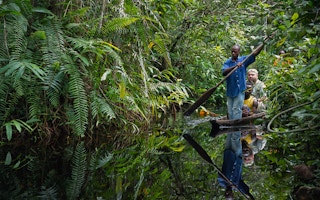An African country whose people are among the poorest on Earth has won plaudits from US scientists for its clear and detailed plans to reduce climate-warming emissions from its forests and farms.
The strategy of the Democratic Republic of the Congo (DRC) – rated next to bottom of the 187 countries on the UN’s Human Development Index in 2013 – is described as “robust” by the US-based Union of Concerned Scientists (UCS).
They also rate it as better than those produced by three other more prosperous countries struggling to combat deforestation − Brazil, India and Indonesia.
The UCS analysed the intentions of several countries for limiting global warming emissions in the agriculture, forestry and other land use (AFOLU) sectors as outlined in their Intended Nationally Determined Contributions (INDCs) – action plans submitted to the UN climate change convention (UNFCCC) explaining how they will reduce their emissions in the 2020s.
Deforestation hotspots
In a report called “INDCs, Take 3” − the final section of a three-part series UCS has released − the scientists say the INDCs from Brazil, India and Indonesia are disappointing, despite their status as deforestation hotspots.
In contrast, they say, the DRC’s plan is robust and in line with a trend that sees smaller countries doing more to reduce their land use emissions than more populated countries.
Doug Boucher, the report’s author and director of the Tropical Forest and Climate Initiative at UCS, says: “The land use sector, which accounts for about one-fourth of total global warming emissions, can’t be ignored if we want to solve the problem of climate change.
“The climate mitigation potential of agriculture and forests is great, and needs to be fully realised to prevent the worst consequences of climate change that will occur if global temperatures rise by more than 2°C.”
In its INDC, Brazil says it will reduce its overall carbon emissions by 37 per cent by 2025, with or without international financing.
But, the UCS says, this does not include the country’s AFOLU emissions. It says its greatest concern is the “inadequate” Brazilian pledge to eliminate only illegal deforestation in the Amazon, rather than limiting all forms of deforestation across the entire country.
Indonesia’s INDC is also problematic, the UCS says. About 63 per cent of Indonesia’s global warming emissions come from the AFOLU sectors, mostly because of deforestation for large-scale agriculture.
The report says it is therefore worrying that Indonesia’s INDC – which proposes a 29 per cent emissions reduction by 2030 compared with business-as-usual, or 41 per cent if it receives international financing – fails to suggest a goal for ending deforestation or peatland clearing.
“
The land use sector, which accounts for about one-fourth of total global warming emissions, can’t be ignored if we want to solve the problem of climate change.
Doug Boucher, director of the Tropical Forest and Climate Initiative at UCS
“Indonesia currently has a moratorium on clearing primary forests and also banned peatland clearing in 2010,” Boucher says. “But the plan doesn’t say whether these commitments will continue, let alone what sort of new initiatives will be implemented to achieve their overall emissions reduction goal.”
Unlike the other countries examined, India is already planting more trees than it is felling. Its INDC lists an overall goal of reducing global warming emissions by 33 per cent-35 per cent by 2030. But the analysis says it “lacks the clarity necessary to effectively gauge India’s ambition, especially with regard to the AFOLU sectors”.
Of the four countries examined, the UCS says, the proposals by the DRC − home to the largest area of the Congo Basin rainforest − were the most clearly defined.
The country offers a 17 per cent carbon emissions reduction by 2030 compared with business-as-usual, and gives a breakdown of how much of this will come from each sector and to what extent each goal depends on international help.
Clearer detail
“The DRC’s plan is clearer and includes more quantitative detail than plans submitted by far richer nations,” Boucher says. “And their proposed reductions are in line with the amount of emissions they can and should cut, based on the extent to which their emissions have contributed to climate change.”
He told Climate News Network: “The governance challenges that the DRC faces in implementing the plans it has presented are enormous. But recent years have actually seen some steps forward among the Congo Basin countries, including reducing an already low rate of deforestation and improving forest monitoring and management.
“So I’m hopeful that the developed world will respond to the DRC’s plans by providing them with the resources necessary to fulfil them.”
The four countries examined in the analysis, together with China, the European Union, Mexico and the US, make up 57 per cent of all land use sector emissions.
“We analysed climate pledges from countries that could make or break climate progress worldwide,” Boucher says. “It’s clear that to be climate leaders, these countries will need to make significant revisions on land use in their INDCs if we hope to effectively tackle emissions from this sector.”










